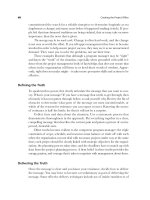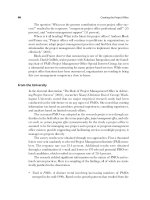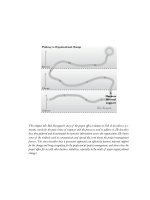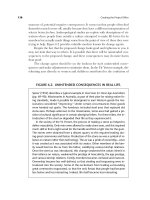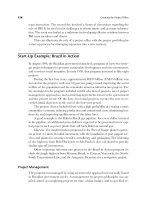Creating the project office 10
Bạn đang xem bản rút gọn của tài liệu. Xem và tải ngay bản đầy đủ của tài liệu tại đây (85.91 KB, 10 trang )
commissioned the search for a reliable timepiece to determine longitude at sea
(implement a change) and many years before it happened (making it stick). If peo-
ple feel that time-honored traditions are being violated, that act may take on more
importance than the news that is given.
The message may be too much work. Change is often hard work, and the change
is not seen as worth the effort. If you tell upper management they have to become
involved in order to help ensure project success, they may see it as an unwarranted
demand. They want you to solve the problems, not use their time.
These examples illustrate that although a program manager may be “right”
and know the “truth” of the situation, especially when grounded with solid evi-
dence from the project management body of knowledge, that does not ensure that
others in the organization will listen to or heed those words of wisdom. Appar-
ently, right does not make might—it takes more persuasive skills and actions to be
effective.
Defining the Truth
To speak truth to power, first clearly articulate the message that you want to con-
vey. What is your message? If you have a message that needs to get through, then
obviously it has not gotten through before, so ask yourself why. Review the list of
obstacles to determine what parts of the message are most uncomfortable, or
which of the reasons for resistance you can expect to meet. Knowing the source
of resistance is half the battle, for then it will not be a surprise.
Collect facts and data about the situation. Use a systematic process that
demonstrates thoroughness in the approach. Put everything together in a clear,
compelling message that describes the current pain and paints a picture of an im-
proved, desirable state.
Other truths become evident to the competent program manager: the triple
constraints of scope, schedule, and resources must balance or trade off with each
other; the organization can not deal with too many projects under way at the same
time; each project should be clearly linked with strategic objectives for the organi-
zation; the planning process takes time; and the deadlines have to match up with
data from the project planning process. A firm belief in these truths provides the
energy, passion, and courage that it takes to negotiate with management about them.
Delivering the Truth
Once the message is clear and you know your resistance, decide how to deliver
the message. You may have to become a revolutionary as part of delivering the
message. Some effective delivery techniques include use of inside/outsiders or of
68 Creating the Project Office
true outside consultants, trying out the ideas as though in jest, or presenting data
from outside sources. If all else fails, you can take the revolutionary road and sim-
ply try to implement the change yourself.
Use an inside/outsider. An inside/outsider is a person who works inside the com-
pany but is outside the particular part of the organization that needs to change,
perhaps residing in the project office. These facilitators are skilled in processes for
getting people to talk about problem areas. The inside/outsider is important for
placing the problems in a company perspective. At HP, a member of the Project
Management Initiative corporate project office often served that purpose.
Hire a consultant. Another approach is to bring in a credible outsider who can
take the first bullets. The consultant can talk about how certain problems are com-
monplace in other organizations, thereby taking direct heat off the upper man-
agers. The consultant can also give examples of how other organizations solved
similar problems. Project office consultants may fulfill this role, especially if they
stay connected with other professionals in the industry.
Work like a court jester. One of the functions of court jesters was to tell bad news
to the king but hide it as a part of a jest. One way to work like a court jester is to
develop a list of common problems, a list so pathetic it causes laughter. Present
the list to upper managers as examples of things that happen in other organiza-
tions. Then encourage the group to discuss the list, a process that is likely to lead
them to determine that these problems may indeed be happening in your orga-
nization. Using this process you never really say that your organization has these
problems, you allow people to discover them for themselves.
Develop objective data from some other source. Let other people or sources identify
the problems. Employee surveys often serve that purpose at HP. The Strategic
Management Group offers PEAT (Project Environment Assessment Tool) based
around work of the authors. The Human Systems Knowledge Network has an
enterprise project management profile service that provides clients with a com-
prehensive assessment of how their enterprise-wide project management prac-
tices compare with those of other members of the network. Using such surveys
allows people to see how their organization compares to others and recognize that
it may be suffering from problems they had not noticed, whereupon you are there
to help with a solution—without having been the one to point to the problem and
thus become the bearer of bad news.
Do it yourself—become a revolutionary. The basic problems with being a revolu-
tionary are that you are usually alone, there is little organizational support for your
ideas, few see the need for your revolution, and you are disturbing the status quo.
If the revolution is not successful, you get shot. However, a revolution may be what
the organization needs, whether it is a sweeping change toward project-based
operations, setting up a project office for a big deal, or simply embarking on a
Powerful Forces 69
significant program. Enlist the help of others both inside and outside your orga-
nization through building a guiding coalition. Overcome fear with courage.
Implementing the Speak Truth Process
A project manager at HP sensed that the organization had serious trouble. There
was no process in place to manage the hundreds of problem issues that had been
identified. For example, there were big gaps in the new computer architecture,
problems so significant that new product development was being delayed. If the
problems were not resolved rationally, immediate decisions would have to be made
that might compromise or severely limit future options for the product line. Archi-
tects argued for the purity and integrity of the architecture. Implementers wanted
pragmatic solutions that leveraged the work completed to date. She was one
among dozens of project managers depending on the new architecture. She had
no more authority than anyone else. But she did have one difference—she was
willing to speak truth to power.
Fortunately, she had already completed a number of projects quite success-
fully. She was technically competent and could understand the difficult nature of
the problems being encountered. She knew action was necessary.
She identified the functional managers whose business was suffering because
of the problems and asked them to get together for a discussion. She put together
a presentation that clearly stated the nature of the problems and their impact on
the businesses. She proposed that each business ante up key engineers to meet in
study groups that would research the options and propose solutions. People in all
project areas needed to review the proposals and agree to adopt them. This work
would have to take place concurrently with development efforts under way. The
upper managers were clearly frustrated by the problems and concerned about get-
ting their projects completed on time. They had no spare resources to resolve
problems that they believed other people should be working on.
Her ability to articulate the current reality clearly and her passion in de-
scribing a future state that was quite different made the difference. She pointed
out the pain that could be felt by each person, she had the ability to design a
process that could lead to changes, and she linked the pain and change efforts to
needs of the business. She created a compelling picture of what needed to be
done, how to do it, and what the results would be. This council of upper man-
agers, now on board as a guiding coalition, asked her to lead the new program.
Believing in the program, she agreed to get it going. She became the leader, the
source of the guiding vision, and the workhorse. She also planned to go out of busi-
ness as a revolutionary as soon as she could. She went to the program management
department and requested a project manager. One of the authors (Englund) came
70 Creating the Project Office
on board and gradually took over as chairman of the Architecture Control Group.
After we successfully completed the tumultuous first phase, albeit behind sched-
ule and over budget, she guided us through the retrospective analysis, saw that we
were on the right path, went back to managing her project full time, and got pro-
moted. We became quite competent on the new process and alleviated much man-
agement anxiety. The computer architecture is at the heart of the huge success
being enjoyed by HP in the computer business. The woman who initiated the
process continues taking on new development efforts within the company.
Another situation sprang from the results of an open line employee survey. A
group doing projects for the field organization scored low on empowerment. Em-
ployees reported that they had little power to make decisions. They were con-
cerned about overmanagement, conflict, mistrust, low levels of openness, and
excessive control.
One of the project managers seized the initiative. Lacking both authority and
the answers, she nevertheless looked around for help. She contacted the project of-
fice—the corporate Project Management Initiative. Armed with data from the sur-
vey, a solid proposal developed with help from the initiative, a proposed forum that
provided the opportunity for open sharing, and her willingness to make a difference,
she got upper management to commit to funding an offsite meeting for managers
and key contributors. She persuaded her peers and upper managers to participate.
Englund arranged to bring in Graham as an outside expert. Graham de-
scribed the Ten Sins of Empowerment (actually he listed only nine . . . and left
one to the groups’ own imaginations, as in Figure 3.3). Drawing on humorous ex-
amples, he succeeded in getting managers to laugh at their foibles. He played a
dual role—the consultant and the court jester. A manager at the meeting was
heard to say, “Certainly we cannot be as bad as the examples portrayed, or are
we? At least we exhibit only some, not all, of the problems.”
An exercise followed the presentation: break into smaller groups, pick one of
the sins to study, conduct a force field analysis, and present your findings to the
large group. The force field analysis consists of the following steps:
1. Describe the current situation.
2. Describe the ideal scenario.
3. Describe a worse scenario.
4. Identify factors that inhibit reaching the ideal.
5. Identify factors that prevent succumbing to the worse.
The first intriguing factor about the break-out discussions was what sins they
would pick. Would they pick the same ones or all different ones? Well, there was
a small mixture. Among the five groups, several different topics were picked. A
Powerful Forces 71
later discussion about action items resulted in pinpointing two areas for attention:
get to know customers better and develop a shared vision.
The general manager was pleased with the session. The truth he received was
how deeply everyone felt about the issues and the uniformity of concerns that
were shared. All involved encountered a safe environment for discussion, the meet-
ing was facilitated by someone outside the immediate business but still from within
the company, and ideas from external experts were presented as healthy models
for consideration. The focus on getting to a small list of action items plus the in-
tensity of the shared discussions furnished motivation for change. The offsite meet-
ing provided the opportunity for managers and engineers alike to discover the
issues themselves and then propose action. This approach has much more stay-
ing power than having a new process imposed by management.
Lessons Learned
A business case can be made that changes are often necessary within organiza-
tions that set out to conquer new territory through projects and project teams,
guided by a project office. The role of upper managers may need to change to
72 Creating the Project Office
FIGURE 3.3. SINS OF EMPOWERMENT.
Questions to ask:
• Want control or results?
• Focus on technique or goal?
• Measure input or output?
• Must team do what you say? (no)
• Are mistakes punished or supported?
Not acting on the preferred answers leads to committing these sins:
1. No focus on strategy
2. Setting arbitrary deadlines
3. Not allowing time for planning
4. Pulling people off the core team
5. Changing specifications due to anxiety
6. Adding people late in the project
7. Low focus on customer and end user requirements
8. Team set in reactive mode
9. Not a learning organization
10. . . .
